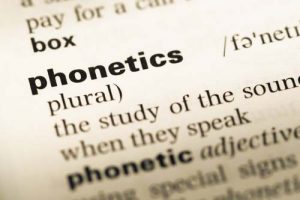 Accent reduction training is something that actors can really benefit from.
Accent reduction training is something that actors can really benefit from.
Indeed, at times, you’ll be playing the role of a character who has an accent of English that is different than the one with which you speak. And the better you can speak with that other accent, the more credible your character will appear and ultimately, the better your performance will be.
If you want to reduce your accent, you have two options: you can either hire a qualified accent coach who’ll teach you exactly how to articulate all the sounds you need, or you can teach yourself how to reduce your accent by working at home.
The latter is precisely what I’m going to show you how to do in 4 steps.
1. Understand How Sounds Are Produced
Regardless of which accent you’ll adopt, you’ll need to be able to articulate its sounds. Some may think that simply mimicking sounds will work. Granted, it might in a few cases, but not everyone has the same ability to mimic sounds of a specific language.
Instead, what I suggest is to get a firm understanding of how sounds are articulated in order to master their pronunciation. These sounds include vowels, consonants, tones and intonation. Various parts of the body are used to produce them.
- Vowels mostly involve moving the tongue blade, the lips and using the vocal cords.
- Consonants tend to be more complex in that their production can require the use of one or more of the body parts we use to produce language sounds. These parts can range from the lips to the lungs.
- Intonation and tones are crucial in reducing your accent. These, thankfully, are much less complex and can be reproduced by mimicking them since they only require the use of the vocal cords.
2. Learning How to Read the International Phonetic Alphabet
Why should you bother with this might you ask? Well, because, as I mentioned before, listening to someone on a piece of audio and then trying to imitate him/her willy-nilly might not yield the desired results.
Phonetic characters, on the other hand, tell you about the exact location where the sound is articulated as well as the manner in which it is produced, something which audio does not indicate clearly to the untrained ear.
And the good news is that you don’t need to be an expert in phonetics to be able to read a phonetic transcription; just understanding the basics will suffice.
You also don’t have to memorize every character in the alphabet. You only need to know how to use the phonetic charts such as this one for the consonants:
Let me give you a possible scenario in which understanding phonetic characters can be beneficial.
Imagine that you have to perform the New York City accent for a role. Well, it turns out this dialect of American English has some consonants which very few dialects of English have.
The TH sound in this dialect is known to be quite difficult to articulate properly by actors. This may very well be due to the lack of understanding of this sound. This is where knowing a bit of phonetics can be very advantageous.
The TH sound in NYC English is called a “dental affricate” by phoneticians and is represented by the symbol t̪͡θ in the international phonetic alphabet. Here’s what “dental affricate” tells us about this sound: its point of articulation is dental, meaning that it is articulated by putting the tongue against the teeth.
Okay, that bit was rather obvious.
But here’s the part that’s much less understood:
This sound is also an affricate, meaning, in simple terms, that it is a combination of two simultaneous sounds. This NYC English TH sound is a combination of the T sound (produced at the teeth) and the TH as in “thing”.
A well-known example of an affricate in English is the J sound found in “jump”, present in several English dialects, which is a combination of the D as in “dog” and the S as in “measure”.
With this information in hand, you’ll have a much better success rate of articulating it correctly. And all of this came from simply understand a phonetic character.
Now, how do you know which phonetic characters are present in an accent so you can learn them? That’s what we’re going to see next.
3. Phonetic Transcriptions in the Accent You Want to Adopt
 There are two things you should do in this step:
There are two things you should do in this step:
- Find accurate phonetic transcriptions in the desired accent;
- Find audio clips in that accent.
The first one, finding phonetic transcriptions, as we saw earlier, will give you instructions on how to articulate the sounds of an accent since phonetic characters carry information about articulation.
Accents of English by Barry Pennock-Speck at the University of Valencia features transcriptions of several English accents. What you need to do is to click on the accent of interest on the left-hand side. Then, click on Examples and you’ll see the transcriptions of that accent. As a bonus, you can even listen to an audio clip accompanying each transcription.
Although less practical, you can also look on Wikipedia for transcriptions. And believe it or not, they’re pretty accurate too. Wikipedia offers phonetic transcriptions in a wide range of English dialects.
The way to tap into this is to click on the individual characters of this vowel chart and this consonant chart that you suspect are present in the accent in question, scroll down to English and look at the list of accents which has this sound. You’ll find a phonetic transcription and sometimes an audio clip.
The second one, finding pieces of audio is much easier. Although, I warn you to be mindful of which accent is spoken on the piece of audio.
Paul Meier’s website has a vast collection of audio samples showing a wide variety of American English accents. I do warn you that you should read the commentary on the accent since sometimes, the accent heard is not always indicative of the region the person is from.
As far as British accents are concerned, the BBC Voices project on the British Library’s website provides several audio samples that you can browse through by county, at the bottom of the page.
4. Master the Intonation
Intonation is often not indicated in transcriptions so for this bit, I’ll invite you to listen to speakers of the accent you wish to adopt and repeat what they say with the proper intonation.
 This also has the added benefit of making you practice the vowels and consonants of that accent. So, you’ll be hitting two birds with one stone.
This also has the added benefit of making you practice the vowels and consonants of that accent. So, you’ll be hitting two birds with one stone.
And there you have it. After you have followed and applied these 4 steps, you’ll be able to reduce your accent without having to hire an accent coach. Good luck!
Marc Belley is a linguist who graduated from the Université de Montréal in Canada. He speaks 4 languages and strives to speak them like a native. He is also the founder of LearnLanguagesOnYourOwn where he teaches a language learning method, which includes an online accent reduction training course.




